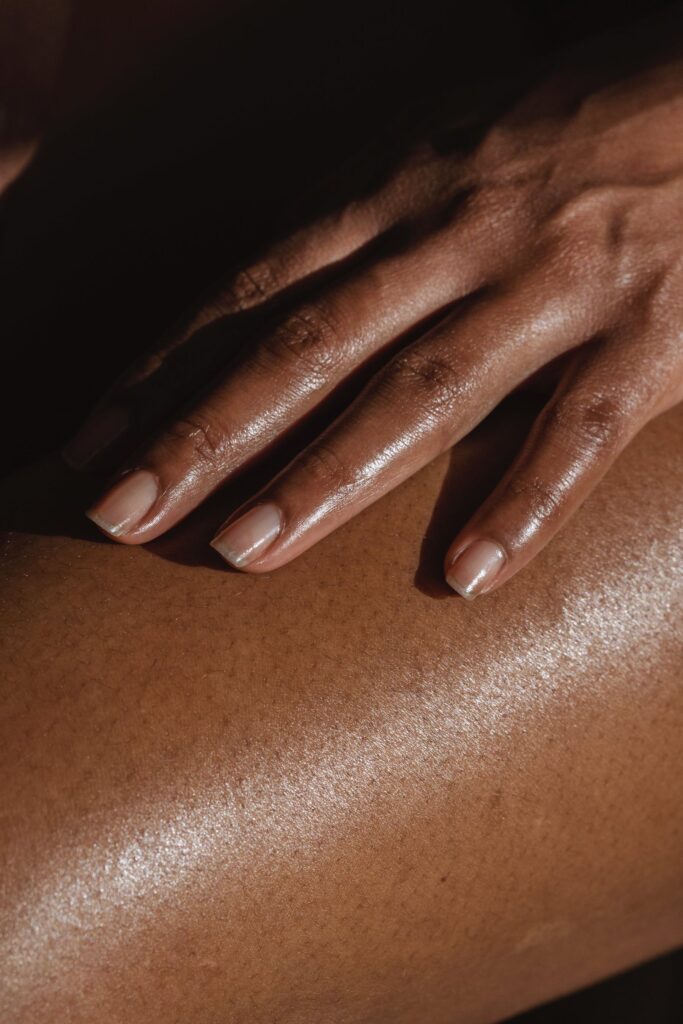
The sun is a constant presence in our lives, offering warmth and light that shapes our daily experiences. For years, we’ve received warnings about the potential risks of too much sun exposure. However, recent research has shed light on how our bodies are intimately tied to the natural rhythms of the sun, influencing our daily activities in profound ways. But did you know that both melanin and melatonin have pivotal roles related to light exposure? This connection holds particular importance for individuals with darker skin. The level of melanin in our skin, which determines how our skin reacts to sunlight, influences the production of melatonin in our bodies. Recognizing this intricate relationship, Yaah! underscores the complex interplay between sunlight and the overall benefits of sun therapy for dark skin.
Navigating the Sun’s Effects on Health
Getting outdoors is a simple way to boost vitamin D levels and reduce the risk of deficiency-related conditions. Vitamin D deficiency has been linked to various health issues, including osteoporosis, heart disease, high blood pressure, cancer, autoimmune diseases, depression, insomnia, arthritis, diabetes, asthma, multiple sclerosis, chronic pain, psoriasis, fibromyalgia, and even autism. The amount of sun exposure needed varies from person to person, depending on factors such as skin type and environmental sunlight levels. For most individuals with fair skin, spending roughly thirty minutes outdoors during the summer, wearing a bathing suit, can generate adequate vitamin D. In contrast, individuals with darker skin may require even more exposure to produce the same amount of vitamin D.
While sunlight is often associated with vitamin D production, it offers a range of health benefits beyond this essential vitamin.
A Sunlight Detox is Just What the Doctor Ordered
Sun therapy, is associated with a range of health benefits, including its role in detoxifying the body. Research indicates that as little as twenty minutes of sun exposure daily can stimulate the production of over two hundred antimicrobial substances in the body, helping combat bacteria, fungi, viruses, and parasites. This natural defense mechanism is particularly effective against harmful microorganisms.
Sun therapy also triggers the release of endorphins in our bodies, natural substances that act as pain relievers and mood enhancers. Our skin contains receptors for endorphins, which are integral to our body’s stress response system. But have you ever wondered how sunlight interacts with dark skin, and what unique advantages it offers?

Melanin and Melatonin UV Guardians
Dark skin, rich in a pigment called melanin, holds a special relationship with sunlight. Melanin is the body’s natural sunscreen, and it acts as a built-in protection mechanism against the sun’s harmful ultraviolet (UV) radiation. This pigment is more abundant in individuals with darker skin tones, making them naturally equipped to handle the sun’s rays. In fact, regions with abundant sunshine, such as Middle Eastern countries and Africa, have lower rates of skin cancer.
Essentially, melanin serves as the first line of defense against UV radiation, reducing its harmful effects on the skin. People with darker skin, who naturally have higher melanin levels, tend to have greater natural protection against sunburn and UV-induced skin damage compared to those with lighter skin.
When our skin is exposed to sunlight, especially during the day, melatonin production in the skin can provide an additional layer of defense against UV-induced damage. By neutralizing free radicals and reducing inflammation, melatonin complements melanin’s UV-absorbing function.
While melanin primarily absorbs and scatters UV radiation at the skin’s surface, melatonin operates at the cellular level to counteract the oxidative stress caused by UV radiation. Together, they form a cooperative system that helps shield the skin from the sun’s harmful effects. The combined actions of melanin and melatonin demonstrate our body’s intricate strategies to mitigate the potential damage caused by UV radiation, promoting skin health and reducing the risk of UV-related skin conditions. But what is the body doing with all of this absorbed sunlight?
The Pineal Gland
The eyes, pineal gland, and skin are all sensitive to light. The pineal gland is affected by light that comes in through the eyes. It is a small, pinecone-shaped gland located deep within the brain, in the center of the head, near the middle of the brain. It’s about the size of a grain of rice and can convert signals from the eyes into chemicals that affect various body functions, so it’s like a translator between our nervous system and hormones. Found in the brain, it plays a role in various bodily processes like controlling our daily rhythms, sleep, and hormone release. It’s interesting to note that this gland is sensitive to light even though it’s deep inside the brain.
The pathway from the eyes to the pineal gland involves several steps, including the brain and the spinal cord. The pineal gland releases hormones and these hormones affect things like our sleep patterns and mood.
Overall, the pineal gland is an important part of our body that connects our eyes and brain to control various functions. Light plays a big role in this connection and understanding it better could have implications for our health and well-being.
The Spiritual Connection
It’s believed that finding the right balance of sun exposure can not only influence physical health but also spiritual well-being which becomes more accessible when the pineal gland is functioning optimally. The pineal gland, has fascinated scholars, philosophers, and spiritual thinkers for centuries, often called the “third eye” or “the seat of the soul.” Some even thought it might be linked to living longer and that problems with the pineal gland could cause aging. The spiritual concept of the “third eye” is often associated with inner perception, intuition, and higher consciousness. Lack of sun exposure might disrupt this balance, affecting both melanin production and pineal gland activity.
In some belief systems, melanin, which is responsible for the pigmentation of the skin, hair, and eyes, is considered more than just a biological pigment. It is seen as a spiritual amplifier, providing a heightened connection to their inner selves or spiritual awareness.
Individuals with darker skin, possessing higher melanin content, can absorb more UV radiation without harm because dark skin absorbs light. This means people with darker skin can have more substantial sun exposure to stimulate the pineal gland and initiate melatonin production during the evening.

The Lightening Effect
Although researchers found that the pineal gland produces a substance called melatonin, and noted skin can get lighter in the dark a long time ago, it wasn’t until the middle of the 20th century that they figured out a “chemical substance” coming from the pineal gland is what makes this happen. What they discovered is that the pineal gland’s light photosensitivity regulates skin pigmentation because the pineal hormone melatonin influences melanin.
Your body has a way to understand when it’s daytime and when it’s nighttime. There are special proteins called opsins that help your brain, specifically the pineal complex, figure out if it’s light or dark. When it’s dark outside, your pineal gland releases a chemical called melatonin, which acts like a signal, letting your body know it’s nighttime.
Now, your skin has some special cells called melanophores, and they can “listen” to melatonin. When melatonin touches these cells, it changes the way they behave. When melatonin is released at night, it tells these melanophore cells to clump together and makes your skin look lighter. It’s like a way your body adapts to the darkness by making your skin paler.
So in the middle of the 20th century, experiments on the pineal gland led to the discovery of melatonin when extracts from cow pineal glands changed the skin color of frogs, causing dark spots and leading to the name melatonin a derivative of melanin. While this research didn’t help treat a skin condition called vitiligo, it did accidentally uncover that melatonin can help with sleep.
Creating a Healthy Circadian Rhythm with Sun Therapy
Exposure to bright morning light plays a crucial role in regulating melatonin production, making it easier to fall asleep at night. This intricate connection is governed by melatonin produced in the absence of light and plays a pivotal role in regulating a multitude of bodily functions. Serotonin is produced during daylight hours and transforms into melatonin in darkness. When serotonin levels are elevated in the presence of melatonin, as often occurs on long summer days bathed in sunlight, our moods tend to improve, and we experience heightened focus and tranquility.
Moreover, melatonin production follows a seasonal pattern, with longer durations during the winter months when daylight is limited. Harnessing the power of bright morning light to fine-tune melatonin production has proven effective in addressing conditions like insomnia, premenstrual syndrome, and seasonal affective disorder (SAD).
If people with darker skin experience lower sun exposure, they might be more susceptible to mood-related conditions such as SAD. Conversely, conditions like SAD are linked to low serotonin levels during the day and a delay in melatonin production at night. Intriguingly, our skin has the capacity to produce serotonin, which can subsequently be converted into melatonin. Our skin cells are equipped with receptors for both serotonin and melatonin. These processes highlight the adaptability of our skin to respond to varying levels of light exposure, contributing to overall well-being and the maintenance of circadian rhythms.

Maximizing Sun Therapy for Health
Scientific research is challenging the prevailing notion that we should shield ourselves from the sun at all costs. Some experts argue that the benefits of UVB radiation, the beneficial form of sunlight, may outweigh the risks. By adopting cautionary measures against sunburn, maintaining a diet rich in antioxidants, and managing fat and calorie intake, we can mitigate the potential risks associated with sun exposure. Antioxidants, such as polyphenols, apigenin, curcumin, proanthocyanidins, resveratrol, and silymarin, have shown promise in laboratory studies for their protective effects against skin cancer caused by UV radiation.
Public health messages should aim to provide a more balanced perspective on sun exposure, considering variations in skin pigmentation among different groups and how these variations affect their susceptibility to the positive and negative effects of sun exposure.
In some African American communities, girls and young women are discouraged from spending time in the sun due to concerns that it may darken their skin. This issue is closely related to colorism, a form of discrimination within a racial group based on skin tone. In such contexts, lighter skin is often deemed more desirable and attractive, while darker skin is viewed less favorably.
Dark skin’s interaction with sunlight is a fascinating and complex process. Our relationship with the sun has profound implications for our health, whether we actively seek sunlight or avoid it. We must recognize how our attitudes towards skin color can influence our sun-related behavior and ultimately impact our well-being. By doing so, interventions can be tailored to be more effective in driving behavioral changes in our community fostering a healthier relationship between individuals and the sun. It’s time to heal the internalized racism about maintaining lighter skin which may lead some individuals to avoid sun exposure to prevent darkening. Achieving a balanced approach to sun therapy, tailored to individual needs and circumstances, can lead to improved health so we can finally see ourselves the way the sun sees us.
Leave a Reply